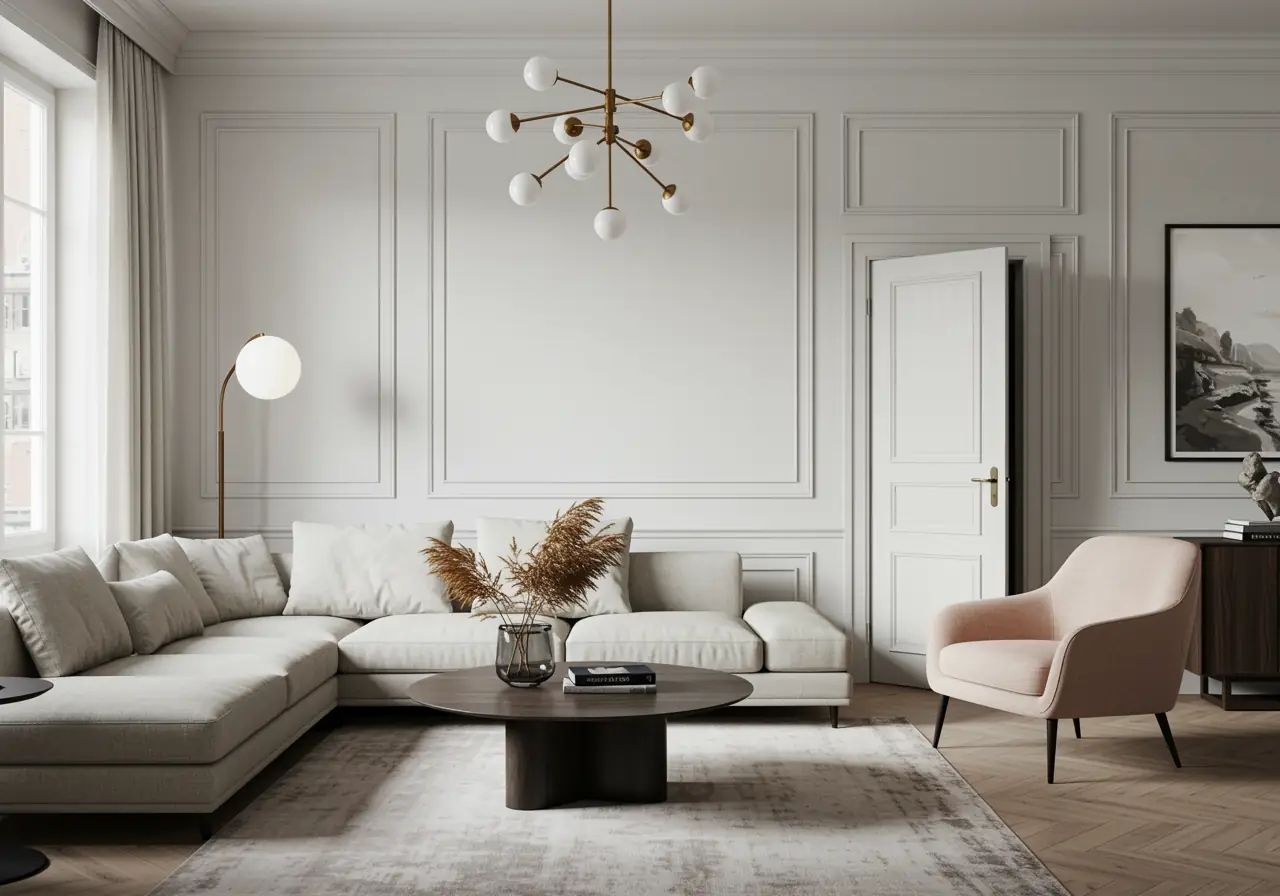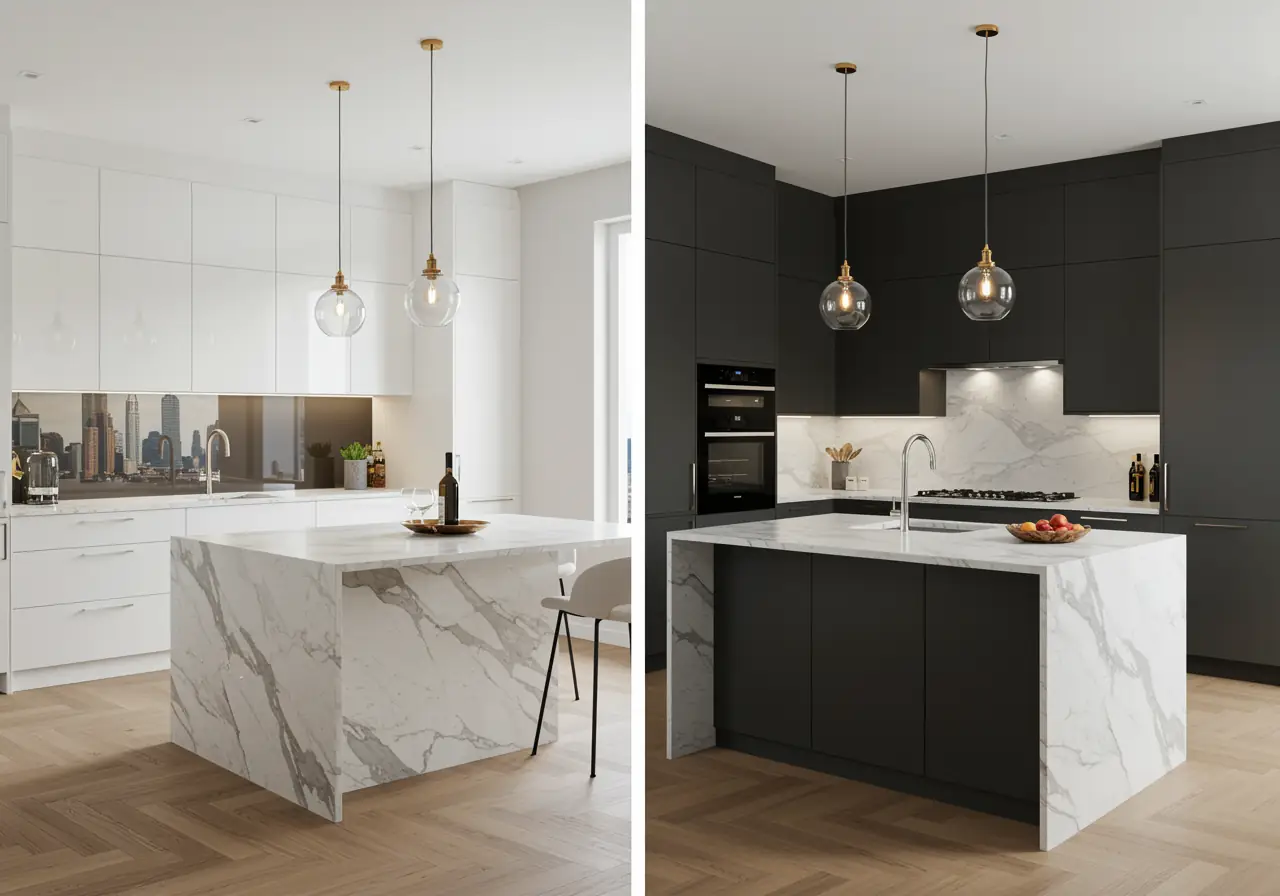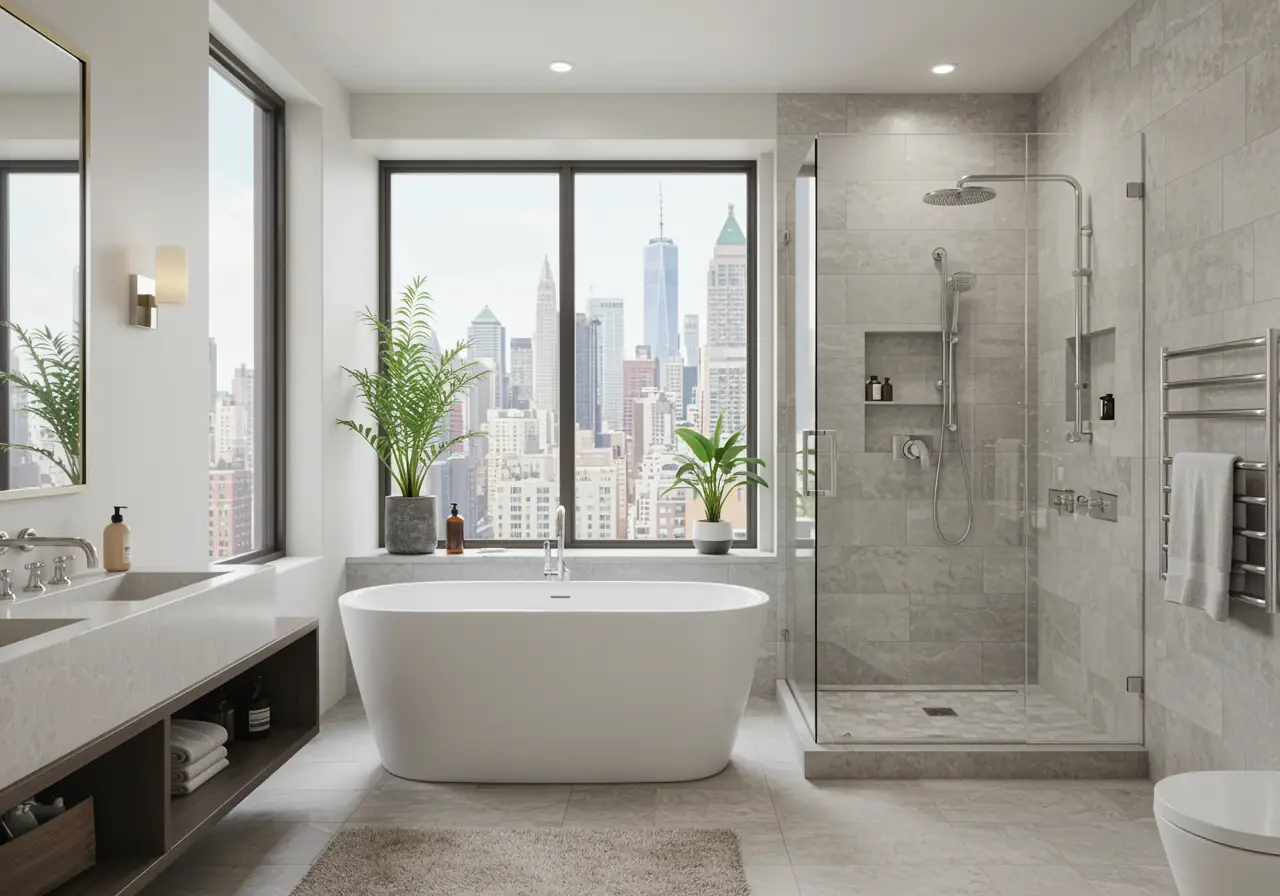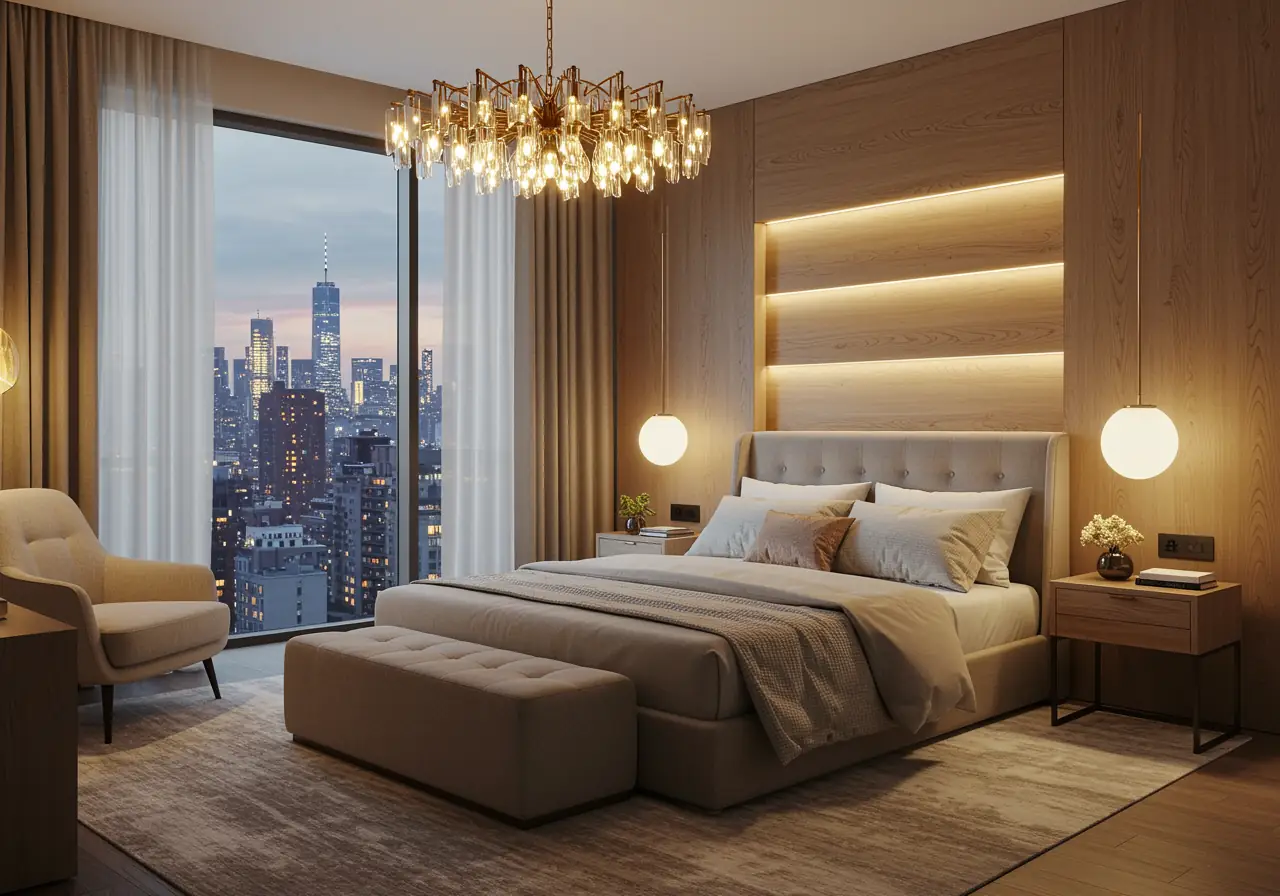Two-Tone Kitchen Cabinets Manhattan 2025: Luxury Design Trend
Two-tone kitchen cabinets have become Manhattan’s top kitchen design trend for 2025, redefining luxury renovation and custom millwork in compact urban spaces. By pairing light upper cabinets with rich, dark base cabinets, this approach creates visual depth, balance, and sophistication that traditional single-color kitchens lack. For Manhattan homeowners seeking both elegance and practicality, two-tone cabinetry delivers timeless appeal while enhancing spatial flow in modern apartments and condos.
This kitchen remodeling strategy transforms limited square footage into functional, airy environments that feel larger and more refined. Beyond aesthetics, color contrast guides the eye, defines functional zones, and elevates daily living with intentional design psychology. Whether blending natural wood tones with painted finishes or mixing matte and satin surfaces, the result is a highly customized kitchen that reflects Manhattan’s signature blend of innovation, craftsmanship, and enduring style.
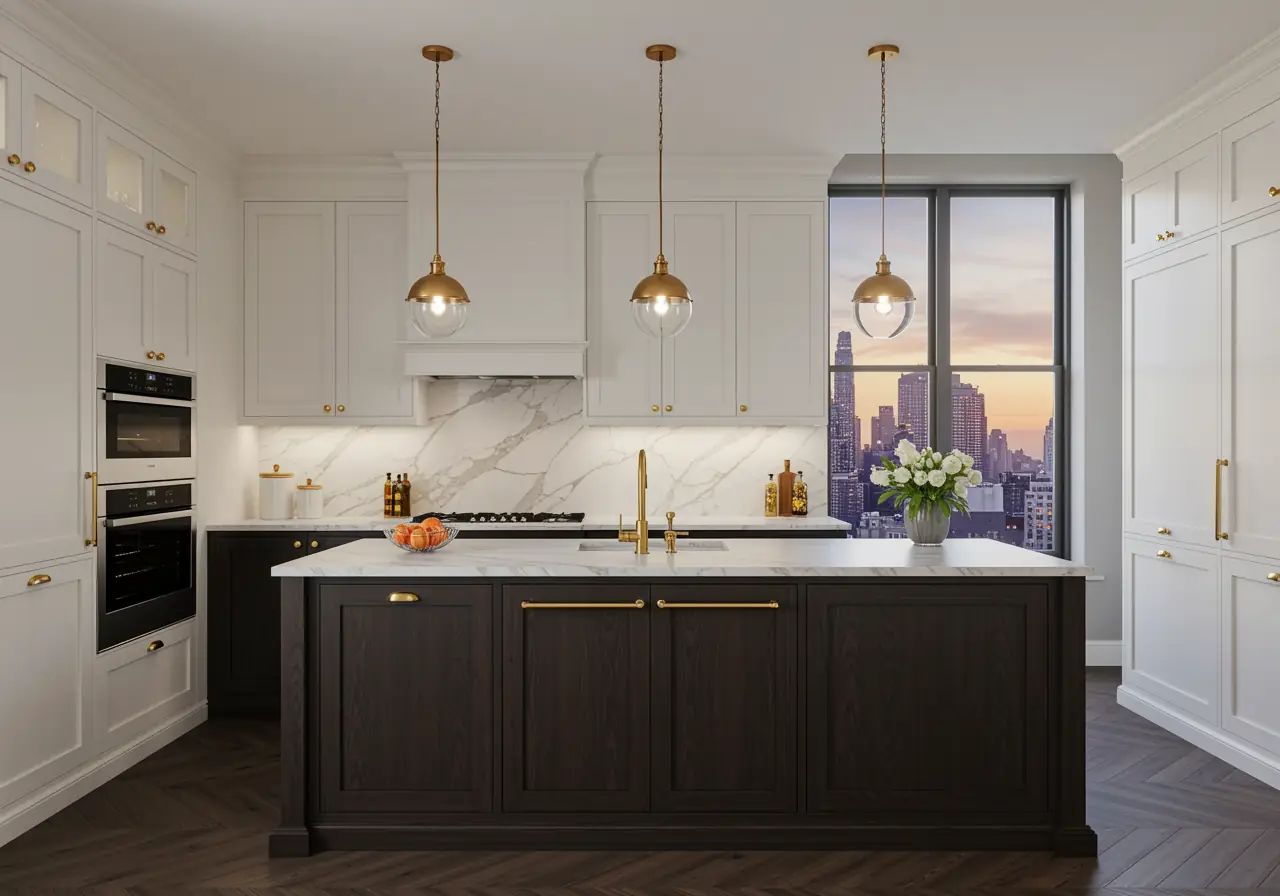
What Makes Two-Tone Cabinets a Manhattan Favorite
Manhattan homeowners have adopted two-tone cabinetry as a strategic response to urban living constraints, moving beyond aesthetic preferences toward practical design solutions that address space limitations and functionality demands.
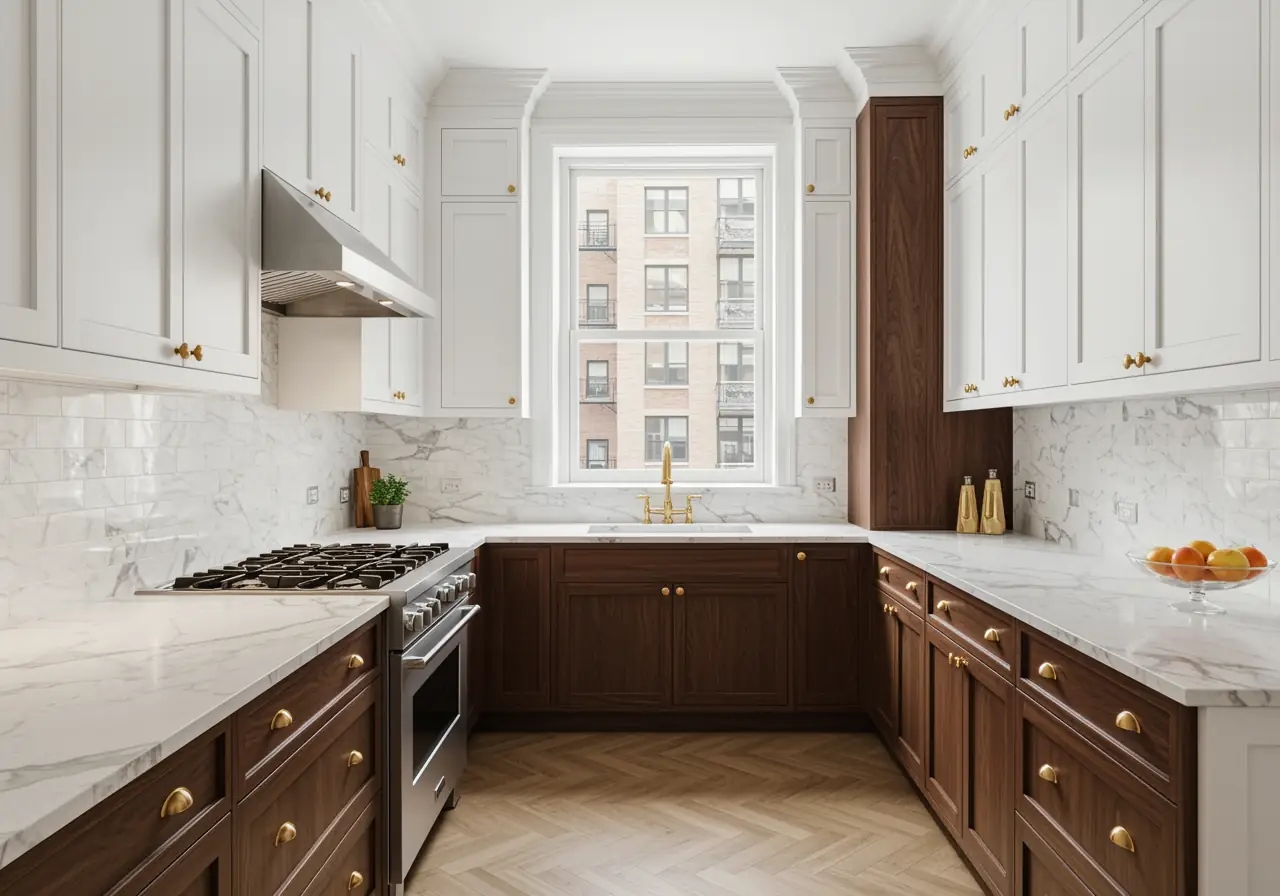
The rise of two-tone kitchens in NYC apartments
Single-color kitchen monotony no longer satisfies Manhattan residents seeking personalized spaces within standardized apartment layouts. Two‑tone kitchen cabinets deliver customized appearances without requiring complete renovations - a crucial advantage when dealing with co-op board approvals and budget constraints. Homeowners escape uniform cabinetry restrictions while maintaining design flexibility for future updates. This approach allows creative expression through strategic color placement rather than committing entire spaces to potentially dated choices.
Why Manhattanites are choosing contrast over uniformity
Manhattan designers favor contrasting cabinet colors because they solve common spatial challenges through visual psychology. Strategic color placement creates anchoring points that guide attention throughout compact kitchens, preventing visual overwhelm in limited square footage. The 60-30-10 rule provides the mathematical foundation - dominant colors cover 60% of cabinetry surfaces, secondary colors occupy 30%, and accent colors finish the remaining 10%. This proportion ensures intentional design rather than random color assembly.
Furthermore, contrast serves practical functions beyond aesthetics. Different tones can define functional zones within open-plan layouts, helping separate cooking areas from dining or living spaces without physical barriers. This color coordination strategy is particularly effective in contemporary kitchen designs where multifunctionality is key.
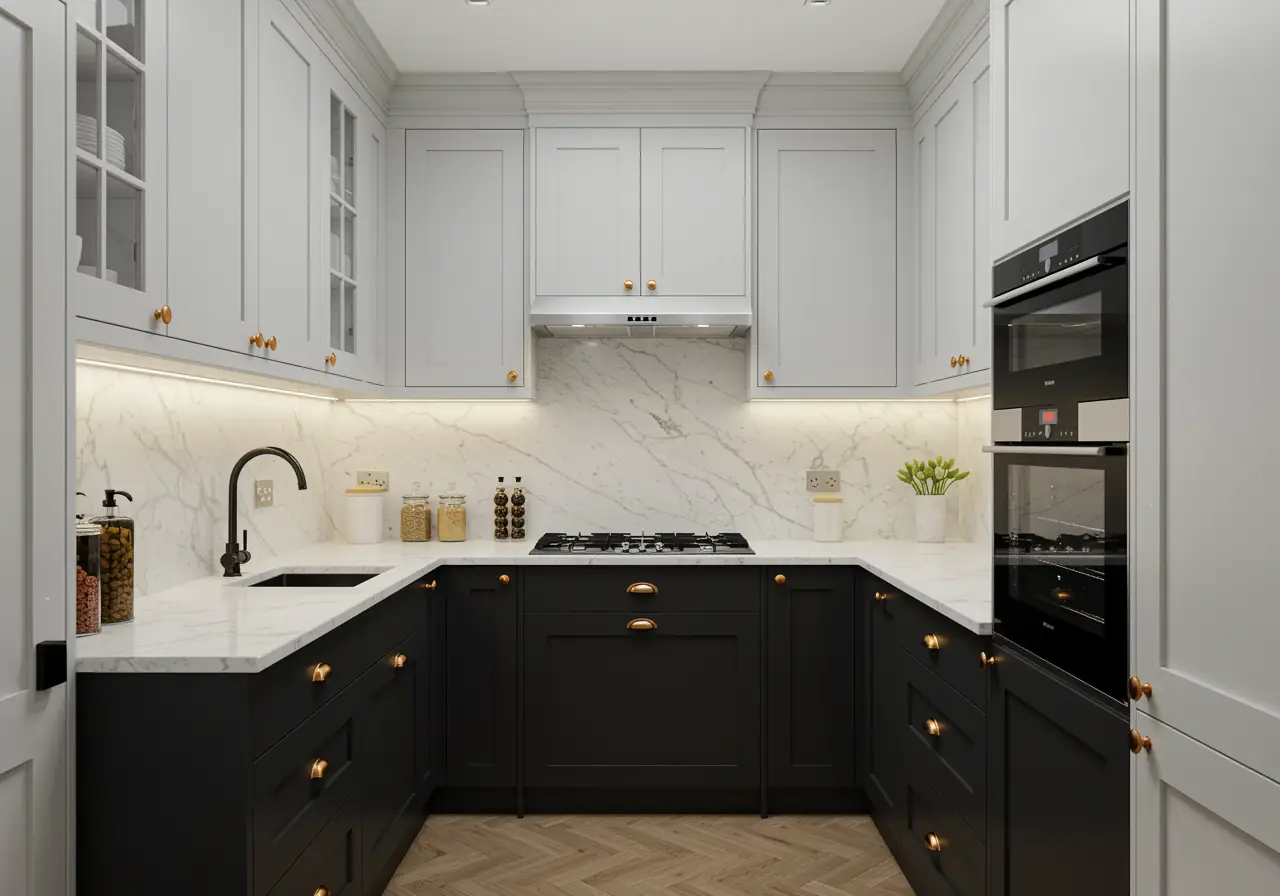
How small kitchens benefit from upper and lower cabinet contrast
Compact Manhattan kitchens gain significant advantages from upper and lower cabinet contrast strategies. Light-colored upper cabinets reflect natural light and create vertical expansion illusions, while darker lower cabinets provide visual grounding that prevents spaces from feeling unbalanced. This contrast technique breaks up visual weight distribution, making cramped quarters appear more spacious without structural modifications.
Lower cabinets receive significantly more wear and tear than upper storage, making darker finishes practical choices for high-traffic areas requiring frequent cleaning. Additionally, Manhattan real estate professionals confirm that two-tone cabinets "show the home isn't cookie cutter, and buyers notice that" - a valuable consideration for property resale potential.
Elevate your Manhattan kitchen with KS Renovation Group’s custom two-tone cabinetry and luxury millwork, crafted for timeless style and smart space design. Our team transforms compact city kitchens into sophisticated, functional spaces with precision craftsmanship and refined detail.
Timeless or Trendy? Understanding the Design Psychology
The psychology behind two-tone cabinets explains why certain combinations endure decades while others quickly feel dated. Kitchen color psychology influences both visual perception and emotional response, creating environments that either enhance or detract from your daily kitchen experience.
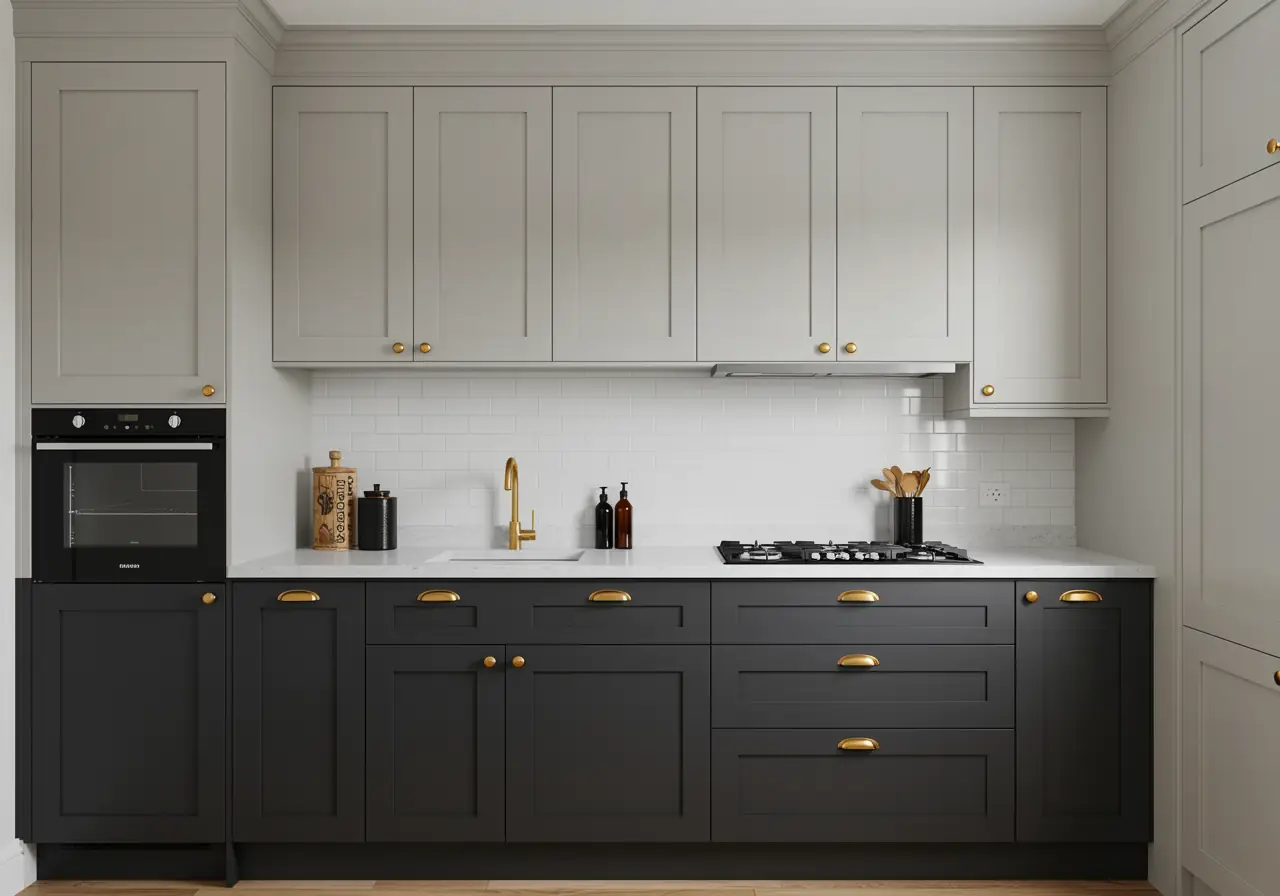
Classic color combos that never go out of style
Neutral palettes prove their staying power through versatility and broad appeal. White, greige, taupe, and mid-tone browns create foundations that adapt to changing decor preferences. White upper cabinets paired with gray lowers deliver crisp sophistication that remains relevant across design cycles. Natural wood tones combined with painted finishes produce subtle variation that showcases craftsmanship while avoiding overwhelming contrast. Wood surfaces trigger stress-reducing hormones, which enhances confidence during cooking activities.
Bold choices that reflect modern kitchen design trends
Contemporary palettes make powerful statements but require careful consideration of longevity. Deep blues paired with white cabinets create dramatic focal points, particularly when enhanced with brass hardware that adds warmth. Emerald green combined with creamy white or beige offers fresh sophistication that feels both current and refined. These combinations reflect design confidence but demand thoughtful evaluation of how they'll age with changing trends.
The psychology of contrast: light vs dark
Cabinet colors shape behavior beyond mere appearance. White surfaces create spatial illusions and trigger what researchers call the "cleanliness effect" - homeowners spend 23% more time cleaning and organizing kitchens with white cabinetry. Dark cabinets establish formal atmospheres that promote mindful eating habits, as contrast makes food portions appear larger and encourages smaller servings. This strategic color placement helps define functional zones while influencing daily kitchen routines.
How to balance trendiness with longevity
Successful two-tone designs follow specific guidelines that ensure lasting appeal. Maintain one neutral tone as an anchor unless pursuing maximalist aesthetics. The 60-30-10 proportion works effectively: 60% dominant color for primary cabinetry, 30% secondary color, and 10% accent elements. Consider maintenance requirements - lighter finishes reveal dirt and fingerprints more readily than darker alternatives. Resale considerations favor lighter cabinets, which attract broader buyer interest in compact urban spaces. Testing sample combinations under your actual lighting conditions prevents costly missteps and ensures satisfaction with the final result.
Bring timeless color psychology and modern design harmony into your Manhattan kitchen with KS Renovation Group. Our experts craft balanced two-tone cabinetry that blends enduring elegance with contemporary character - designed to enhance both your space and your lifestyle.
Top 4 Two-Tone Cabinet Styles Dominating 2025
Kitchen design professionals identify four distinct two-tone cabinet approaches that deliver exceptional results for Manhattan homeowners. These combinations prove effective because they address both aesthetic preferences and practical urban living requirements.
1. Neutral base with bold uppers
Reversing traditional expectations, this approach pairs neutral base cabinets with richly pigmented upper cabinets. White or cream bases support sage green, navy blue, or rust-colored uppers without creating visual weight that compresses small spaces. Consequently, the neutral foundation provides stability while bold upper cabinets introduce personality above eye level.
Manhattan apartments with abundant natural light particularly benefit from sage green uppers paired with warm white lowers. This nature-inspired palette shifts throughout the day as light conditions change, creating dynamic visual interest without overwhelming compact spaces. Furthermore, this combination allows bold color expression while maintaining resale flexibility through neutral lower elements.
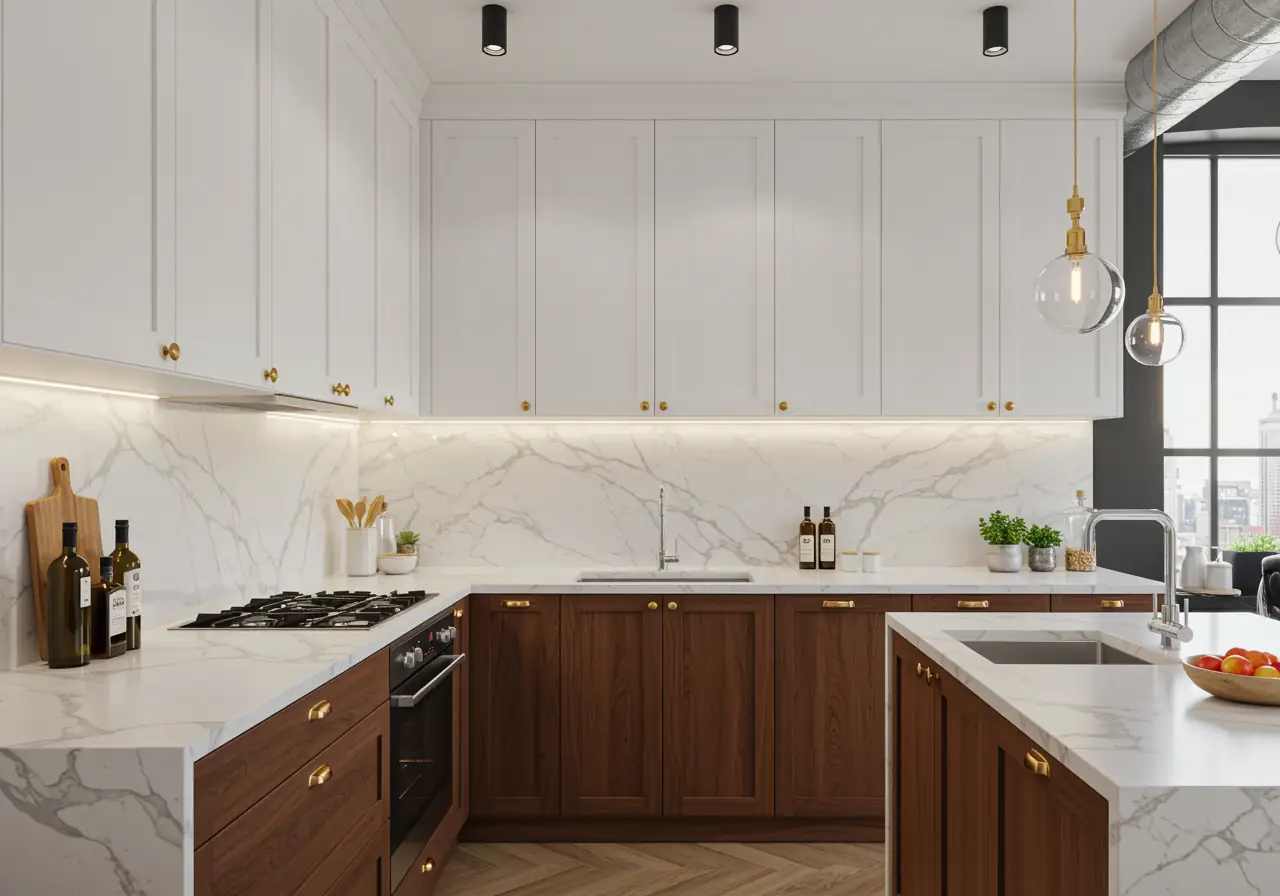
2. Wood and painted finish pairings
Natural wood combined with painted surfaces creates sophisticated contrast that brings warmth to urban kitchens. Stained wood cabinets for lowers paired with painted uppers establish an organic foundation while maintaining fresh, clean lines above. Oak, maple, and cherry wood components offer distinct grain patterns that add textural depth beyond simple color variation.
This pairing proves particularly valuable because it delivers both warmth and practicality. Wood grain cabinets handle daily wear more gracefully than painted finishes, while painted uppers reflect light and prevent dark wood from overwhelming smaller spaces. Additionally, wood elements connect Manhattan kitchens to natural materials often absent in urban environments.
3. Contrasting kitchen islands
Kitchen islands serve as ideal testing grounds for bold two-tone experimentation. Contrasting island cabinets in emerald, charcoal, or navy create intentional focal points that anchor entire kitchen designs. This strategy proves especially effective in open-plan Manhattan apartments, where contrasting islands help define cooking zones within larger living areas.
Successful island contrast requires thoughtful integration with existing cabinetry. Islands should share architectural details like door profiles and soft-close hardware while differing only in color. Consequently, this approach allows dramatic color statements without disrupting overall design cohesion. Furthermore, contrasting islands provide opportunities to introduce premium finishes within manageable budgets.
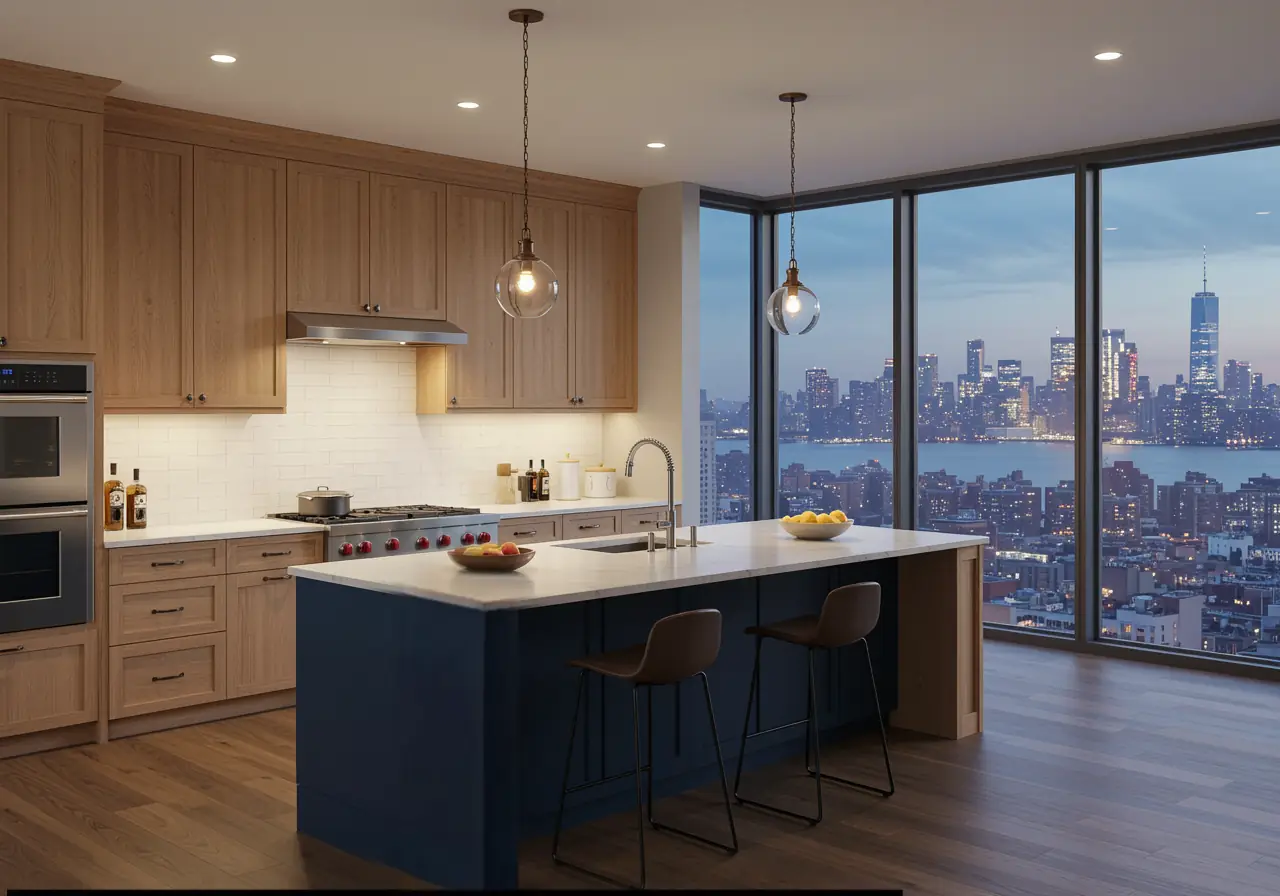
4. Black and white luxury combos
Black and white cabinet combinations represent sophisticated two-tone design at its pinnacle. This pairing creates maximum visual contrast while maintaining timeless appeal that adapts to changing decor preferences. Black lower cabinets paired with white uppers establish grounded sophistication that never feels dated.
Practically, this combination addresses Manhattan living challenges effectively. Dark lower cabinets conceal everyday wear and kitchen mess, while white uppers reflect precious natural light and prevent spaces from feeling enclosed. Additionally, black and white combinations enhance architectural details and create crisp lines that emphasize quality craftsmanship throughout your kitchen design.
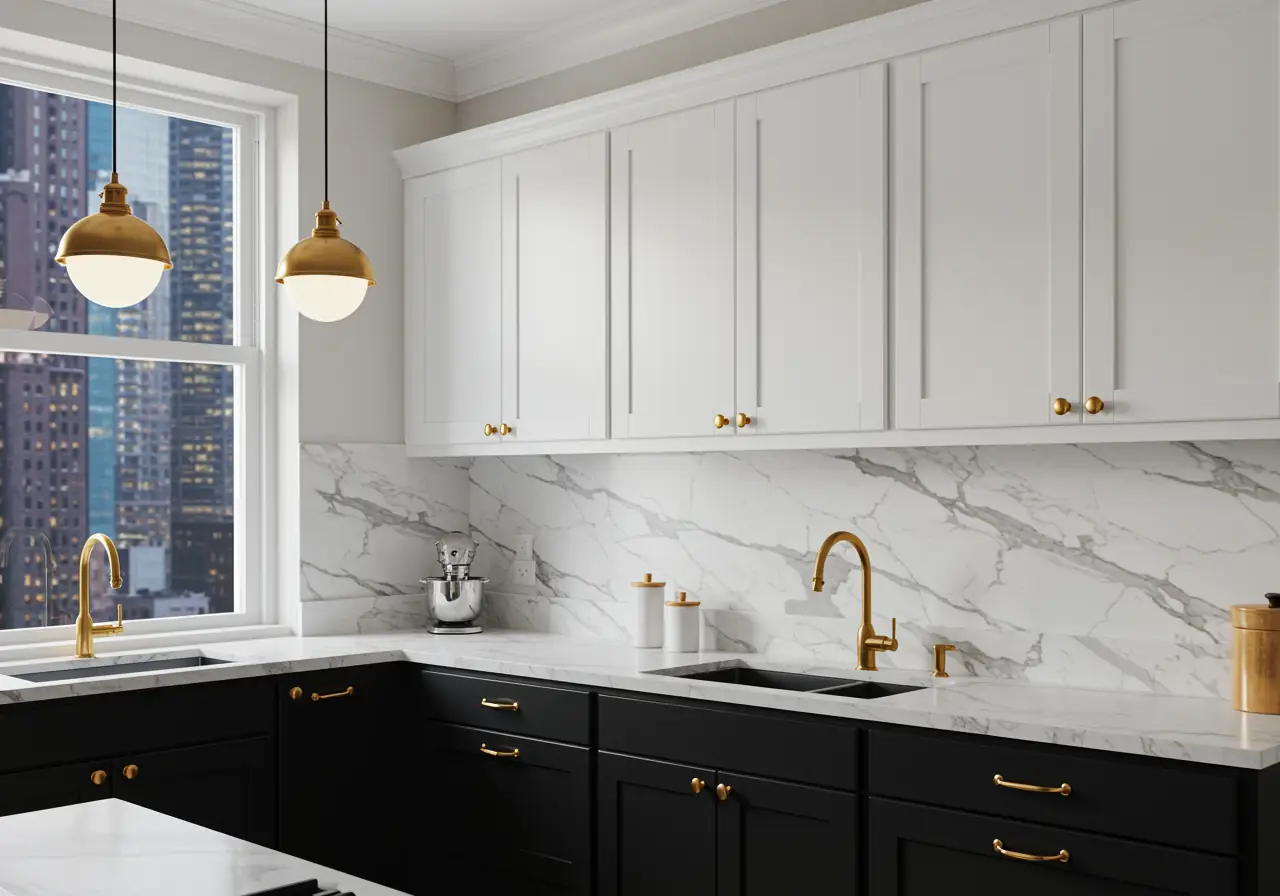
Practical Considerations Before You Commit
Several critical factors determine whether your two-tone kitchen investment delivers long-term satisfaction. These practical elements separate successful installations from costly mistakes.
Cleaning and maintenance tips for two-tone finishes
Different cabinet finishes show wear differently - light colors hide grease better yet may yellow over time, whereas dark finishes reveal dust more readily. Daily maintenance requires only a microfiber cloth with minimal pressure. Deep cleaning involves mixing warm water with a few drops of mild dish soap, wiping down cabinets, then drying immediately. Harsh chemicals and abrasive tools damage paint finishes and void warranties.
How cabinet color affects resale value
Two-tone cabinets actually increase home appeal, showing buyers your kitchen "isn't cookie cutter". Maximum resale value comes from neutral combinations and softer tones. Blues, greens, grays, and natural finishes typically retain lasting value, whereas bold high-contrast colors risk feeling outdated quickly.
Choosing finishes that last: matte, gloss, or satin?
Satin finishes offer the ideal balance between durability and style for two-tone kitchens. Semi-gloss provides excellent moisture resistance but shows fingerprints prominently. Matte finishes hide imperfections effectively yet require gentler cleaning techniques.
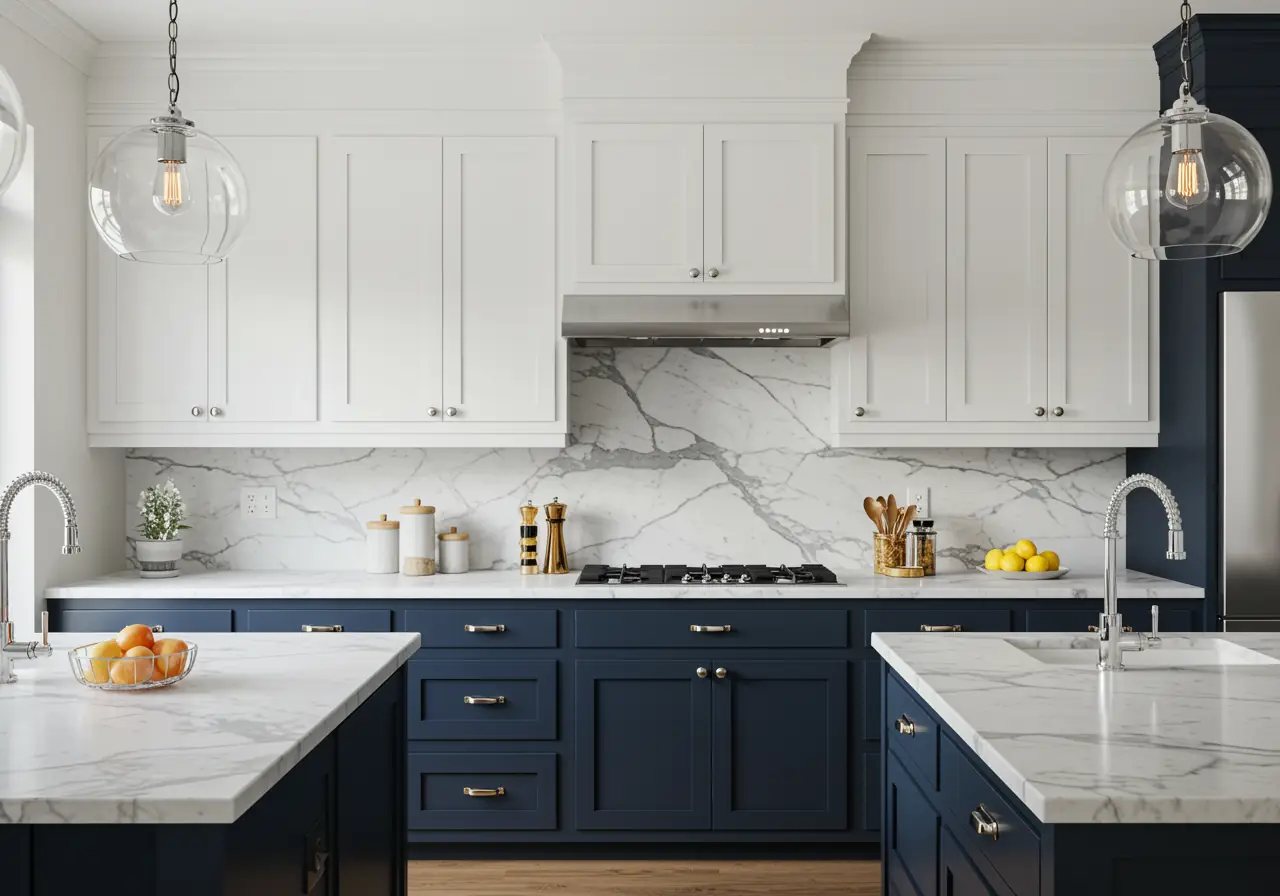
Custom millwork vs prefab: what's worth the investment?
Custom cabinets provide perfect fit, superior materials like solid wood, and increased home value - albeit at significantly higher cost. Prefab options work adequately for standard layouts but lack personalization opportunities that distinguish Manhattan properties. When considering cabinet selection, evaluate your long-term goals and budget constraints.
Request a sample set to visualize your dream kitchen
View samples in your actual space under different lighting conditions before finalizing any color combination. Natural light, overhead fixtures, and under-cabinet illumination all influence how your selected colors appear throughout the day. Many kitchen showrooms offer sample sets to help with cabinet selection and color coordination.
Achieve lasting refinement with KS Renovation Group. Our specialists create custom two-tone kitchens with precise craftsmanship, premium finishes, and expert installation - bringing enduring beauty and functionality to every Manhattan home.
Conclusion
Two-tone kitchen cabinets remain the ultimate choice for Manhattan homeowners seeking modern elegance, functional design, and long-term property value. This luxury kitchen renovation trend combines timeless color pairing, custom millwork, and spatial efficiency - ideal for compact Manhattan apartments and condos. By blending light upper cabinets with darker base tones, homeowners achieve depth, balance, and visual expansion without structural changes. Neutral foundations with rich accent colors ensure versatility for evolving interior styles and strong resale appeal in Manhattan’s competitive real estate market.
Professional installation and careful finish selection - matte, satin, or gloss - guarantee lasting durability and flawless execution. Testing cabinet samples under real lighting conditions prevents design mismatches and ensures cohesive, high-end results. As 2025 kitchen design continues emphasizing multifunctionality and sophistication, two-tone cabinetry stands as Manhattan’s defining trend - delivering both enduring beauty and practical performance.
Refine your Manhattan kitchen with KS Renovation Group. Our team transforms design concepts into handcrafted two-tone spaces that balance elegance, precision, and practicality - delivering a sophisticated finish tailored to your home and lifestyle.
Key Takeaways
Manhattan's two-tone cabinet trend offers a sophisticated solution that combines visual appeal with practical benefits for modern kitchen design.
• Two-tone cabinets create visual space in small Manhattan kitchens by pairing light uppers with dark lowers, making rooms feel larger and more open.
• Classic combinations like white-and-gray or wood-and-painted finishes offer timeless appeal, while bold pairings risk becoming dated quickly.
• The 60-30-10 color rule ensures intentional design: 60% dominant color, 30% secondary, and 10% accent colors for balanced visual impact.
• Satin finishes provide optimal durability and style balance, while different colors require specific maintenance approaches for longevity.
• Two-tone designs actually increase resale value by showing buyers the kitchen "isn't cookie cutter," especially with neutral color combinations.
This color-blocked luxury look represents more than esthetics - it's a strategic design philosophy that maximizes both form and function in urban living spaces. Before committing, always request sample sets to test your chosen combinations under your actual lighting conditions.
FAQs
Q1. Are two-tone kitchen cabinets still trendy in 2025? Yes, two-tone kitchen cabinets remain a popular trend in 2025. They offer visual interest, can make small spaces appear larger, and provide a balance between timeless appeal and contemporary style. Thoughtful color combinations like white uppers with darker lowers or wood finishes paired with painted surfaces are particularly favored.
Q2. What are the most popular color combinations for two-tone cabinets? Popular two-tone cabinet combinations include neutral bases with bold uppers (like white lowers with sage green or navy blue uppers), wood and painted finish pairings, contrasting kitchen islands, and classic black and white combinations. These options offer both visual appeal and practical benefits for various kitchen sizes and styles.
Q3. How do two-tone cabinets affect resale value? Two-tone cabinets can actually increase home appeal and resale value. They show potential buyers that the kitchen isn't "cookie-cutter" and has been thoughtfully designed. For maximum resale value, it's best to stick with neutral combinations and softer tones that have lasting appeal.
Q4. What finish is best for two-tone kitchen cabinets? Satin finishes are often considered ideal for two-tone kitchens as they offer a good balance between durability and style. They're easier to clean than matte finishes and don't show fingerprints as readily as high-gloss options. However, the best finish can depend on your specific needs and preferences.
Q5. How do I maintain two-tone kitchen cabinets? Maintenance for two-tone cabinets depends on the colors and finishes chosen. Generally, use a microfiber cloth for daily cleaning. For deeper cleaning, use a mixture of warm water and mild dish soap, wiping down cabinets and drying immediately. Avoid harsh chemicals and abrasive tools that can damage paint finishes. Remember that lighter colors may show grease while darker colors tend to reveal dust more readily.

KS Renovation Blog
Get Inspired
Meaningful information about home remodeling for the true NYC homeowners.
OUr Clients Say
NYC kitchen remodeling Projects and more



